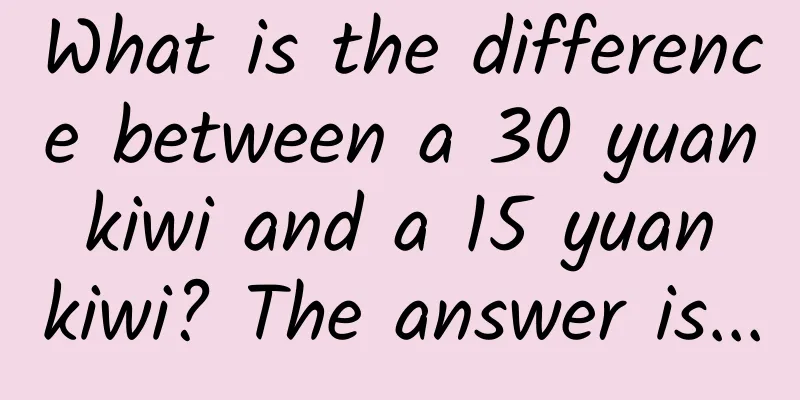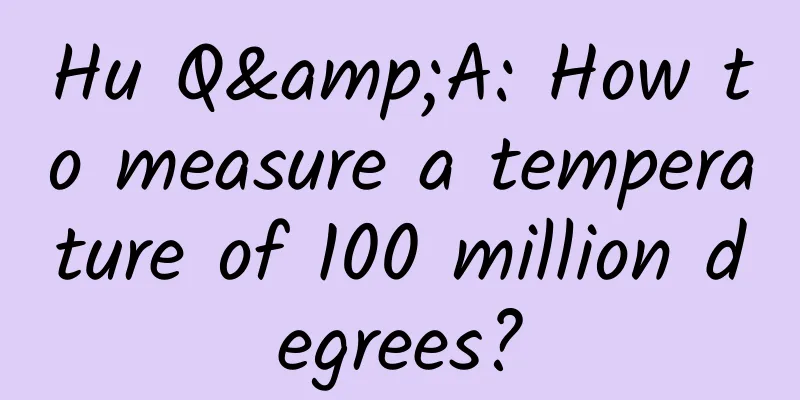What is the difference between a 30 yuan kiwi and a 15 yuan kiwi? The answer is...

|
Many people have eaten or seen kiwi fruit and kiwifruit in their daily lives. They should not be unfamiliar with these two fruits, which have different names but are almost the same in shape and appearance, especially their prices, which make us remember them most. Usually in supermarkets or online stores, different prices are set for Chinese kiwifruit and New Zealand kiwifruit. For example , the price of kiwifruit is about 15 yuan per catty, while the price of kiwifruit is about 30 yuan per catty, a difference of as much as twice. Copyright images in the gallery. Reprinting and using them may lead to copyright disputes. Seeing this, we can't help but wonder why these two fruits with almost the same appearance and shape have such a significant price difference? Are they the same fruit? The origins of kiwifruit and kiwifruit revealed As we all know, China is an important birthplace of kiwifruit. Historically, as early as 700 AD, there were written records of "kiwifruit" in China. Later, Li Shizhen also commented on kiwifruit, saying: "Its shape is like a pear, its color is like a peach, and kiwis like to eat it." From the perspective of resource distribution, 52 of the 54 wild kiwifruit species discovered in the world are distributed in China . It can be said that China's kiwifruit not only has rich germplasm resources, but also has a long history. However, the New Zealand kiwifruit we see in the market today is not only very similar to the Chinese kiwifruit in appearance and shape, but also has a texture and taste that is not much different from the Chinese kiwifruit. We may have an idea in our minds: Are they the same fruit? Congratulations, you got it right. New Zealand kiwifruit and Chinese kiwifruit are the same fruit , both perennial vines belonging to the genus Actinidia in the family Actinidia. There is actually a little story behind their different names. The story can be traced back to the Qing Dynasty in 1904. Isabel, a New Zealand teacher, came to Yichang, Hubei to visit her sister. During the visit, she met Wilson, a botanist who was collecting plant resources in China. Isabel was very interested in the kiwifruit collected by Wilson, so she brought some seeds back to New Zealand after the visit. These seeds were first planted sporadically on New Zealand farms, and later New Zealand farmers and breeders saw the huge edible and economic value of kiwifruit, so they invested a lot of money in artificial domestication. After decades of efforts, New Zealand finally succeeded in domesticating wild kiwifruit into commercial fruits represented by Hayward, which are rich in nutrients, sweet and sour, and have a unique flavor. In order to maximize the selling price and earn huge economic benefits, New Zealand growers observed that kiwi fruit has similar fine hairs and colors to New Zealand's national bird, the kiwi, so they renamed kiwi fruit kiwi fruit, which is translated into Chinese as kiwi fruit. At the same time, a unified national brand Zespri was established to uniformly manage the planting and sales of New Zealand kiwi fruit. Since then, kiwi fruit has become a world-famous fruit by virtue of its reputation as New Zealand's national bird and excellent fruit quality. Copyright images in the gallery. Reprinting and using them may lead to copyright disputes. So, now everyone understands that although New Zealand kiwifruit is the leader in the fruit world, it is actually the Chinese kiwifruit, which was just artificially taken out of China and then changed to a foreign name. If when you are buying fruit, the shopkeeper tells you that kiwifruit is not kiwifruit, so it is more expensive, please don't be fooled. Why are kiwis so expensive? Since kiwifruit and actinidia are of the same origin and are the same fruit, why is there such a big difference in price? First, New Zealand began to plant and improve kiwifruit in 1904, and formed large-scale commercial production around 1940. However, due to many factors such as the transition from the old society to the new society, the change of government, years of war and the limitations of the times, China did not start to pay attention to the kiwifruit industry until 1978. Before that, the scientific research and industry of Chinese kiwifruit were still blank. Since Chinese kiwifruit started late and was not as competitive as New Zealand, it failed to occupy a dominant position in the kiwifruit market. Secondly, although kiwifruit and kiwifruit belong to the same kind of fruit, New Zealand kiwifruit has a better quality. The reason is that Zespri Kiwifruit Company attaches great importance to scientific research investment. Every year, it gives a large amount of scientific research funds to third-party breeding institutions for kiwifruit breeding and improvement . At the same time, it has also established a special scientific research department to improve the scientific and technological content of each link in the development of the industry. In addition, the New Zealand government also pays great attention to the development of the kiwifruit industry, not only increasing the supporting support for scientific researchers, but also regularly funding huge amounts of funds for basic research in the kiwifruit industry. In China, there was a lack of sufficient scientific research support and advanced cultivation technology in the early stage, and the understanding of kiwifruit was not deep enough, which also led to the fact that the quality of Chinese kiwifruit was slightly inferior to that of New Zealand kiwifruit. Finally, kiwifruit is good at building brand advantages and increasing added value. In order to promote the development of the kiwifruit industry, New Zealand requires all fruit farmers to abandon their own brands and collectively establish a unified kiwifruit brand: Zespri. All kiwifruit planting, packaging, storage, transportation and distribution are brought under unified management and are under the unified responsibility of the New Zealand Kiwifruit International Marketing Company. It is precisely because of the establishment of a unified, efficient and strictly controlled quality support system that kiwifruit has become a fruit that has attracted worldwide attention. In contrast, China's current brand building is still immature, with a mixed quality of varieties, a lack of brands that can carry the banner in the international market, and no clear management entity. Many brands fight on their own, and internal friction is serious, so New Zealand kiwifruit can repeatedly win the first place. Chinese kiwifruit, a latecomer However, although New Zealand's kiwifruit industry is relatively mature, in recent years, New Zealand kiwifruit is no longer the only dominant player. On the contrary, China's kiwifruit industry has begun to catch up with its competitors and has created many breakthroughs in the world. For example, Wuhan Botanical Garden has preserved more than 1,400 kiwifruit resources since 1978 and cultivated 45 varieties with different characteristics over the past 45 years, greatly enriching China's kiwifruit variety resources. In addition, varieties such as Jintao, Jinyan, Donghong and Zhongmi No. 2, which were cultivated by Chinese scientists over more than ten years, are also loved by the general public and have become the main cultivated varieties in China. Not only that, these varieties are also favored by foreign consumers and have gone abroad, and have been introduced and cultivated in countries such as Italy. At the same time, relying on its rich kiwifruit resources, China has vigorously cultivated kiwifruit with different flesh colors, such as the unique red flesh kiwifruit varieties "Donghong" and "Hongyang". If we cut the red flesh kiwifruit horizontally with a knife, we can clearly see that the core of the fruit is radiating red, while the flesh of other parts is green or yellow. The colors are very rich and the appearance is better than the previous kiwifruit. What we should be proud of is that China is the only country in the world that can cultivate these kiwifruit varieties with rich flesh colors. Due to the lack of germplasm resources, countries such as New Zealand and Chile have not yet been able to cultivate them independently and can only introduce them from China for planting. Copyright images in the gallery. Reprinting and using them may lead to copyright disputes. It is precisely because of the unremitting efforts of Chinese agricultural science and technology workers that China's kiwifruit industry has ushered in a new world. In the past, Chinese farmers could only choose to plant the "Hayward" variety bred in New Zealand, but now there are many Chinese kiwifruit varieties for them to choose from. This change not only allows farmers to have more planting options, but also allows us as ordinary people to have the opportunity to taste many different and delicious kiwifruits. Today, Chinese kiwifruit seems to have grown wings and soared to 90,000 miles. The planted area has accounted for more than 60% of the world's total, and the planting output has surpassed New Zealand, accounting for 50.5% of the world's total. It has gradually regained the international voice in kiwifruit and greatly promoted the development of China's kiwifruit industry. How to choose kiwi fruit correctly? With the development of agricultural technology in China, the variety of kiwifruit available for selection is increasing. However, facing the dazzling array of kiwifruit on the market, how can we choose kiwifruit that is both delicious and durable? In fact, the method is very simple. Just remember the appearance, hair and hardness. 1. Look at the appearance: Choose kiwi fruits that are plump, evenly colored, and without spots or scars on the surface. Also, try to choose fruits with dark yellow-brown skin, as this will make the taste sweeter. 2. Look at the fuzz: Due to different varieties, the fuzz on the kiwifruit skin will also be different. According to the type of fuzz, you can also choose kiwifruits with different flavors. Generally speaking, the green-fleshed kiwifruits with obvious hard hairs or rough skin taste a little sour, while the red-heart and yellow-fleshed Chinese kiwifruits with smooth skin taste a little sweeter. 3. Look at the hardness: Choose kiwifruit that is relatively firm overall. Squeeze it gently with your hands. You should not feel that the whole or part of it is soft. Otherwise, the kiwifruit may have been stored in the store for too long and cannot be stored for consumers. After reading this, I believe many of you have learned about kiwis and exotic fruits. Curious friends can order these two fruits to taste and compare them personally. I believe that domestic kiwis are no worse than exotic fruits. Planning and production Author: Li Ting, member of China Science Writers Association Review丨Cheng Xuzhen, Researcher, Institute of Crop Sciences, Chinese Academy of Agricultural Sciences Planning丨Ding Zong Editor: Yinuo The cover image and the images in this article are from the copyright library Reprinting may lead to copyright disputes |
<<: Drinking tea incorrectly can harm your health! These 3 types of people should drink less
Recommend
China Passenger Car Association: July 2023 Automobile Retail Sales Ranking Quick Report
According to the latest retail sales data from th...
Why do Chinese people like Audi and foreigners like Mercedes-Benz? We are really different
Some people say that among domestically produced ...
Want to upgrade to iPhone 7? It’s not too late to check these minor issues before buying
With the global release of iPhone 7 and iPhone 7 ...
Does your nose itch when spring comes? Interesting facts about pollen
Spring Blossoms Itchy nose? Cool facts about poll...
Faraday Future Financial Report: Faraday Future's full-year operating loss in 2024 narrowed by 47.7% year-on-year to US$149.7 million
Recently, Faraday Future (NASDAQ: FFAI, FF for sh...
What is the existence of a pig farming O2O project that is said to be valued at 1 billion US dollars?
[[153523]] Wang Dapeng was going to the countrysi...
Domestic mobile phones set their sights on India: Is it really that easy to make money?
When it comes to India, the author's impressi...
Analysis of Zuoyebang’s product strategy (Part 2)
Zuoyebang is committed to providing learning tuto...
Breaking news: A moving hairline does not necessarily mean hair loss!
"When you are young, you don't know how ...
Be careful with this heating device! In addition to burns and fire, it will also cause formaldehyde to exceed the standard
Your home heater may be a hidden "killer&quo...
Winter vacation is approaching. How can online education institutions recruit students and attract customers?
Another winter vacation is approaching, and holid...
No. 1 in hot search, Zhong Xuegao responded!
Yesterday at noon, @钟薛高 issued a statement, Ranke...
The routine for creating “screen-sweeping” and “explosive” marketing cases!
Nowadays, there are far more people who write art...
You were an ugly duckling when you were young, and you became a white swan when you grew up. What did you go through in between?
The Spring Festival holiday is over, and handsome...
The Lanzhou server next to the company crashed again
Noon The haze in the imperial capital has not yet...









